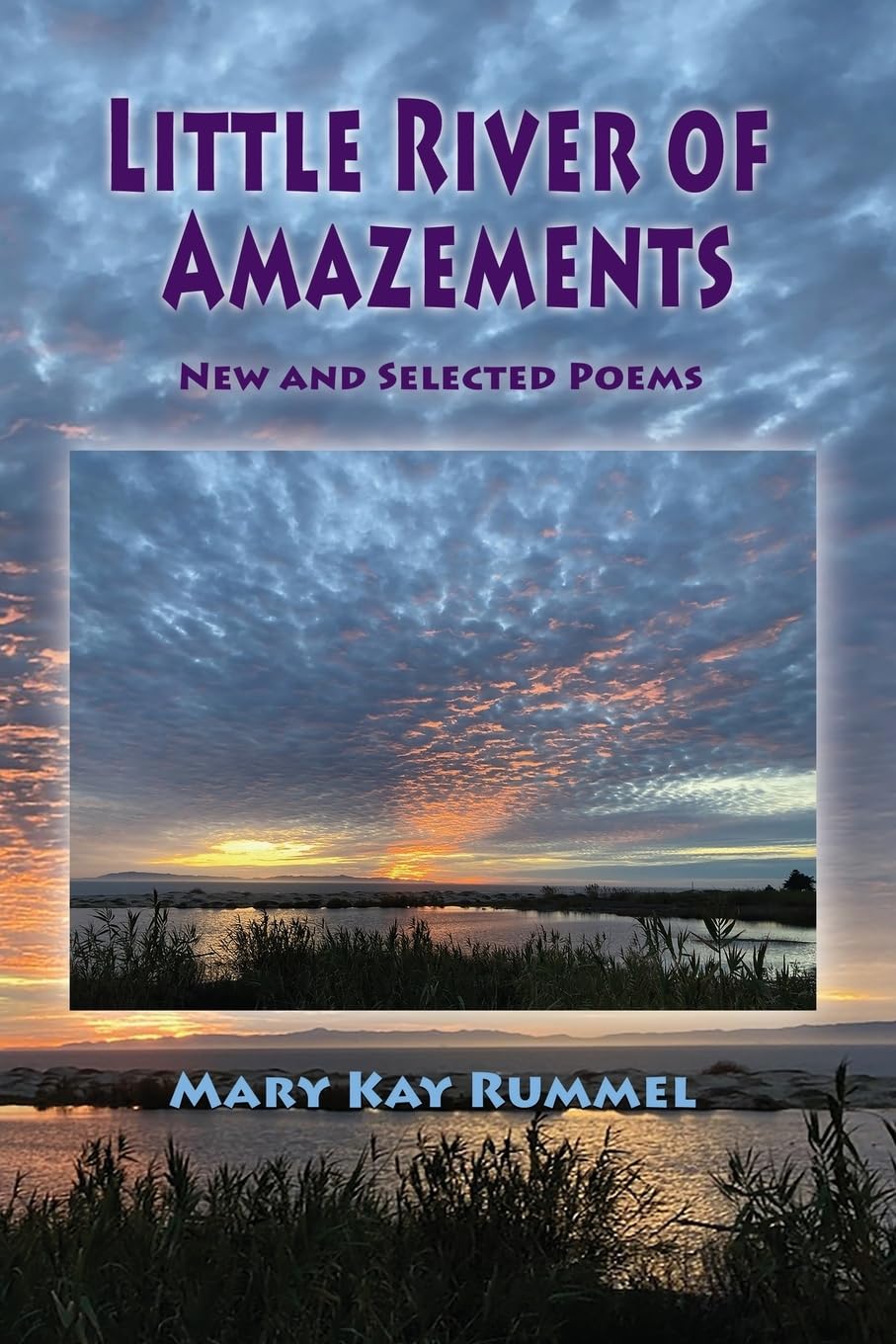Reviewed by Charles Rammelkamp
Little River of Amazement
by Mary Kay Rummel
Blue Light Press
March 2024, $23, 236 pages, ISBN: 978-1-4218-3557-0
In addition to fifty pages of new poetry, Mary Kay Rummel’s new collection includes excerpts from six previous collections dating back to her 1989 book, This Body She Entered. Many themes tie the book together, enduring preoccupations throughout her career, including vast travel experiences, a deep engagement with her spirituality, especially as it relates to nature, devotion to family, and her complicated history with religion, especially the Catholic Church, in which she was raised.
Indeed, we can glean Rummel’s poetic agenda from her poem, “Ars Poetica” from her 2014 collection, The Lifeline Trembles, in which she describes her grandmother bringing the Irish language “across a stormy Atlantic to St. Paul”; her cousin taking bribes from Chicago gangsters to help out that grandmother when she was a widow; growing up “in the quotidian music of women’s murmuring,” and telling her own grandchildren tales of trolls and beanstalks. All of these experiences, perhaps unremarkable in the eyes of the outside world, compelled Rummel to take up her pen. She concludes the poem:
Because love will not let go
I do not want to die without writing
my unwritten watery universe.
Mary Kay Rummel’s universe is vast, but as “Ars Poetica” spells out, she focuses on the world around her with a keen attention to detail. The title, indeed, says it all.Little River of Amazement comes from one of the new poems, “December Bodies,” in the first of her two-part suite of new work, For the Speechless World. She’s observing the white pelicans as they momentarily “bless the shallow Ventura river / with their stillness.”
Then it’s gone –
the little river of amazements
curved through sand, swallowed by sea.
Waves roll over, a last thin swerve
where fresh water meets salt.
She’s talking about the Ventura, of course, but how much of life is made up on these little glimpses, a river of amazements, indeed. But Rummel covers a lot of ground, geographically, in her poetry, from Paris to St. Paul, Thailand to Guatemala, Ireland to Istanbul.
The pelicans are one of those little details, and they appear several times in Rummel’s new work, along with bats, gulls, crows, dolphins, loons. ”Pelicans in the Rain” opens with an epigraph from Claude Monet: “A single lifetime is not long enough to know even a single moment.” Rummel’s reverence for nature is profound. In “Winter Solstice in Big Sur” she writes:
I face the moon and bow,
breathing with trees
in the circle of redwoods.
Their silence a murmuration –
a wave of evergreen and pine
surrounds my fear,
fills my emptiness.
Contrast this spiritual longing with her observations on the God she grew up believing in. In “Life is Losing and Reinvention” she tells us:
We worshipped an old god-man
like the one in renaissance paintings,
loving that red wine smell,
his eyebrow hairs sticking out
like the legs of spiders.
She further spells this out in the poem “Sonata for Gulls and God”:
I lost the old God I was given
at birth – who rewarded
and punished;
who was there each morning
and now is gone.
Vincent Van Gogh is another artist whom Mary Kay Rummel esteems. “Wheatfield With Crows, Vincent Van Gogh” is one of her new poems, but he is all over her work. “Sunflower,” from her 2017 collection Cypher Garden and “Finding Blue” (“Dragonfly blue rushes through / a quick and private joy.”) from 2020’s Nocturnes: Between Flesh and Stone are examples, and the title poem from the 2010 collection, What’s Left Is the Singing, is a true homage to Van Gogh. It begins:
The first time I walked into that red
gallery, Van Gogh’s iris leapt
from the wall. There, I thought, is God.
Family is important to Mary Kay Rummel as well. She writes about her parents, siblings, and ancestors. Her mother in particular is a subject over and over again. She invokes her mother in poems like “Histories” (“When I read my mother’s writing / I hear her, see her hand shaking.”) and “A History of Rain” in her 2006 book, The Illuminations; she invokes her in “Step on a Crack” from This Body She’s Entered, and several of the new poems, “Diagrammer of Sentences” and “Son et Lumière: Chartre” (“When my mother at eighty was dying…”)
But it’s the poem “Hugging Bridget After the Pandemic” that drives home the value she places on family. Presumably, Bridget is a granddaughter. Rummel writes about her in the poem “Mother Tongue” from Cypher Garden (“Inside, you live / all the tender words we give you / so you can make your way / through the glittering world.”). In the new poem she celebrates the reunion with her grandchild after the separation of the lockdown:
I am a house full of crickets.
She folds into my hollows,
candled and warn,
crawling back
into the original story.
The curled frond where life began
begins again.
The final poem in Rummel’s new work, concluding the second section, Against the Dark, is called “With The Memory of Water,” which is after a poem by the San Francisco poet, Tongo Eisen-Martin. The final two lines reiterate Rummel’s spiritual stance, her approach to life:
You remember how you said to yourself, yes,
and did not know the word for why.
Mary Kay Rummel embraces her experience, relishes her senses, her loved ones. She does not question the reasons for this. It simply is, and it’s right.
About the reviewer: Charles Rammelkamp, is Prose Editor for BrickHouse Books in Baltimore and Reviews Editor for The Adirondack Review, and author of Mortal Coil, A Magician Among the Spirits, and See What I Mean? published by Kelsay Books in 2023.




